Jasper Lake Fanless Showdown: ECS LIVA Z3 and ZOTAC ZBOX CI331 nano UCFF PCs Review
by Ganesh T S on July 8, 2022 8:30 AM EST- Posted in
- Systems
- ZOTAC
- Fanless
- ECS
- Passive Cooling
- UCFF
- Mini-PC
- Jasper Lake
System Performance: Miscellaneous Workloads
Standardized benchmarks such as UL's PCMark 10 and BAPCo's SYSmark take a holistic view of the system and process a wide range of workloads to arrive at a single score. Some systems are required to excel at specific tasks - so it is often helpful to see how a computer performs in specific scenarios such as rendering, transcoding, JavaScript execution (web browsing), etc. This section presents focused benchmark numbers for specific application scenarios.
3D Rendering - CINEBENCH R23
We use CINEBENCH R23 for 3D rendering evaluation. R23 provides two benchmark modes - single threaded and multi-threaded. Evaluation of different PC configurations in both supported modes provided us the following results.
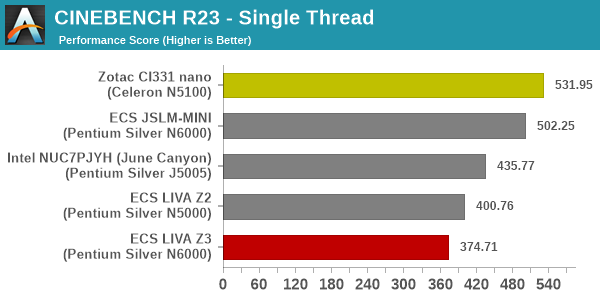

The ZOTAC CI331 nano, with its PL1 limit set to 7W, while the LIVA Z3 / JSLM-MINI have it at 6W. Coupled with the thermal throttling in the LIVA Z3, it is no surprise that the CI331 nano comes out on top in the single-threaded case despite its lower advertised clocks. The JSLM-MINI leaves the Z3 behind due to the thermal throttling issue. With multiple threads in the picture, the actively cooled June Canyon NUC with its higher power budget takes the crown.
Transcoding: Handbrake 1.5.1
Handbrake is one of the most user-friendly open source transcoding front-ends in the market. It allows users to opt for either software-based higher quality processing or hardware-based fast processing in their transcoding jobs. Our new test suite uses the 'Tears of Steel' 4K AVC video as input and transcodes it with a quality setting of 19 to create a 720p AVC stream and a 1080p HEVC stream.
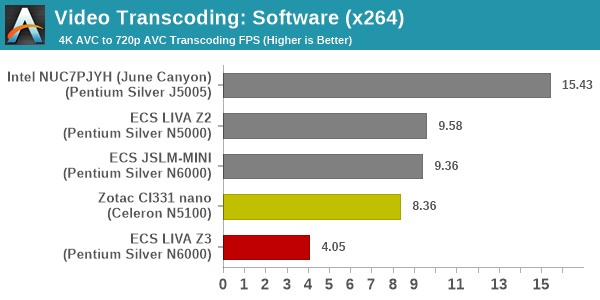
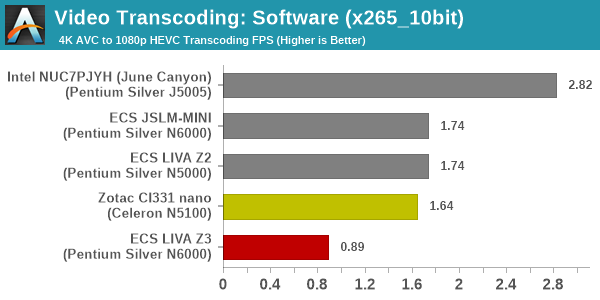
The factors influencing the software transcoding rate are power budget and core count. While the latter is the same for all systems (four cores with one thread per core), the power budget for the June Canyon and its active cooling (allowing it to maintain 10W throughout) help it in coming out on top. The ZBOX suffers slightly in this sustained loading test. As we shall see in a later section, the system is not up to the task of sustaining 7W over extended durations.
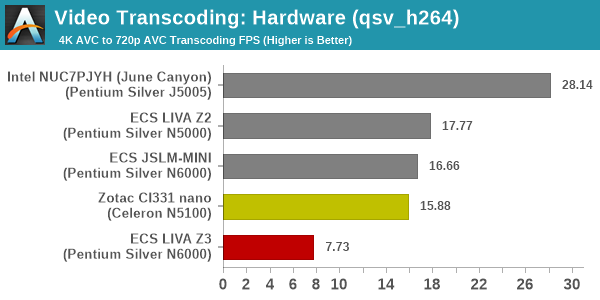
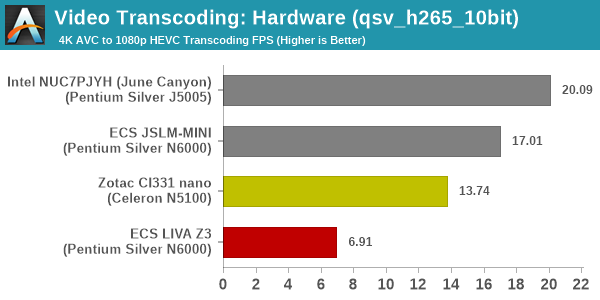
Hardware-accelerated transcoding rates are a function of GPU clock rates and power budget. The actively-cooled Gemini Lake system with its higher iGPU power budget leads the pack. The close numbers for LIVA Z2 and JSLM-MINI for AVC encoding show that the QuickSync engine itself doesn't have performance improvements in going from Gemini Lake to Jasper Lake. The Z3 and the CI331 nano both appear to be throttled in the HEVC transcoding test.
Archiving: 7-Zip 21.7
The 7-Zip benchmark is carried over from our previous test suite with an update to the latest version of the open source compression / decompression software.
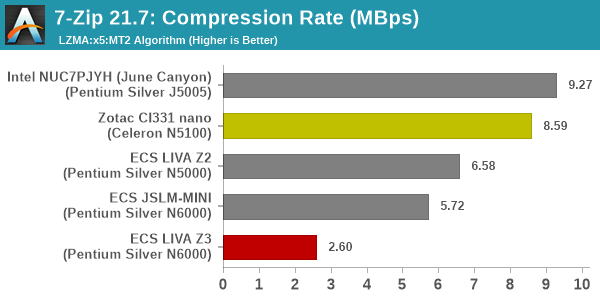

Power budget matters for the relatively short-running 7-Zip benchmark. Ignoring the actively-cooled June Canyon, we see the 7W PL1 limit of the CI331 nano helping it to lead the pack among the passively-cooled systems.
Web Browsing: JetStream, Speedometer, and Principled Technologies WebXPRT4
Web browser-based workloads have emerged as a major component of the typical home and business PC usage scenarios. For headless systems, many applications based on JavaScript are becoming relevant too. In order to evaluate systems for their JavaScript execution efficiency, we are carrying over the browser-focused benchmarks from the WebKit developers used in our notebook reviews. Hosted at BrowserBench, JetStream 2.0 benchmarks JavaScript and WebAssembly performance, while Speedometer measures web application responsiveness.
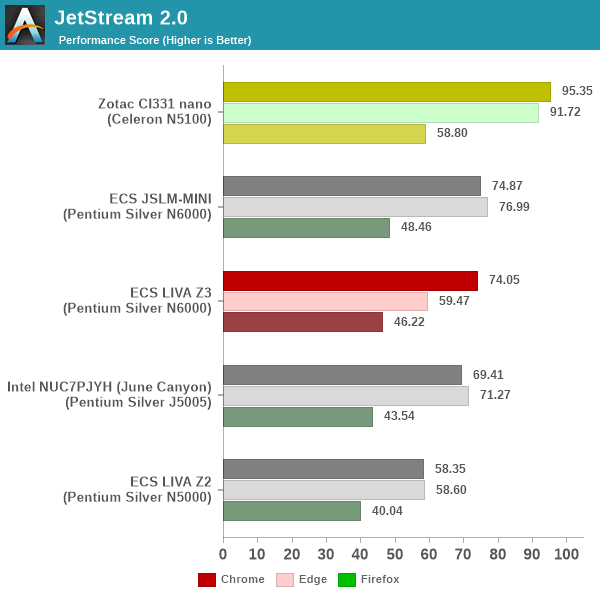
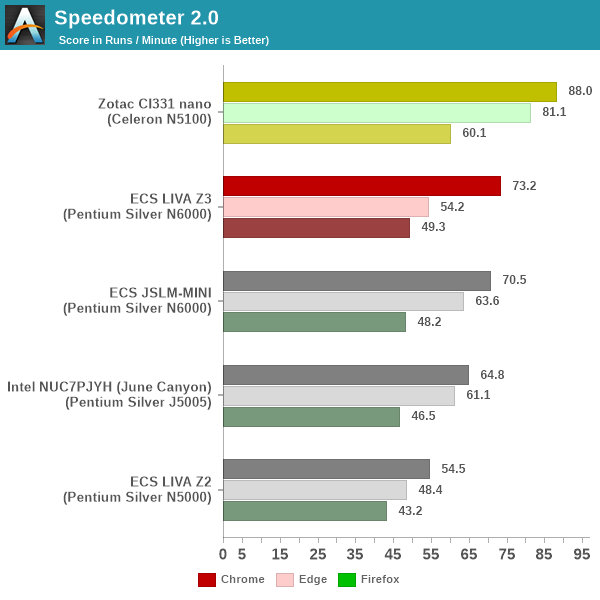
From a real-life workload perspective, we also process WebXPRT4 from Principled Technologies. WebXPRT4 benchmarks the performance of some popular JavaScript libraries that are widely used in websites.
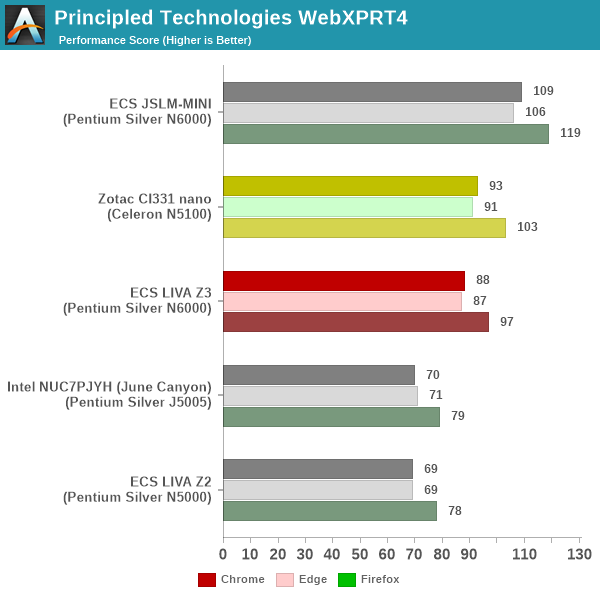
The microarchitectural improvements in Jasper Lake come to the fore in these benchmarks. Despite the higher power budget and active cooling, the June Canyon NUC with a 10W Gemini Lake processor is left well behind by all the passively-cooled Jasper Lake systems. WebXPRT4, in particular, is long-running and reflective of typical web browser usage. The fact that the fanless systems still come out with better scores despite any thermal throttling reflects well on the improvements in Tremont over Goldmont Plus.
Application Startup: GIMP 2.10.30
A new addition to our systems test suite is AppTimer - a benchmark that loads up a program and determines how long it takes for it to accept user inputs. We use GIMP 2.10.30 with a 50MB multi-layered xcf file as input. What we test here is the first run as well as the cached run - normally on the first time a user loads the GIMP package from a fresh install, the system has to configure a few dozen files that remain optimized on subsequent opening. For our test we delete those configured optimized files in order to force a fresh load every second time the software is run.
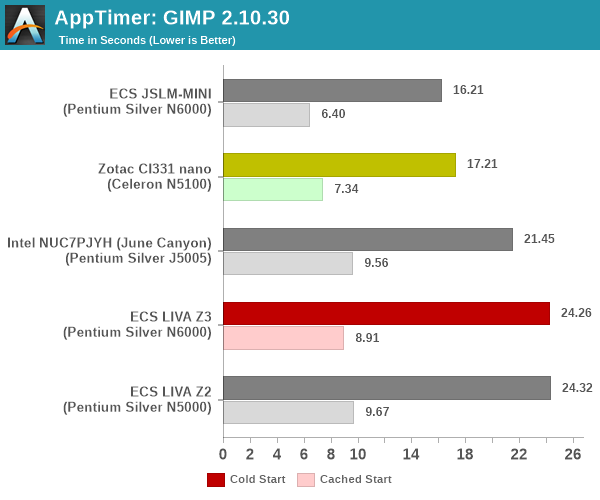
As it turns out, GIMP does optimizations for every CPU thread in the system, which requires that higher thread-count processors take a lot longer to run. So the test runs quick on systems with fewer threads, however fast cores are also needed. The thread count for all processors are the same in the considered systems. Since it boils down to fast cores, the power budget and the ability to sustain it helps. As we shall see in a later section, the JSLM-MINI is the least susceptible to thermal throttling, and that works in its favor.










52 Comments
View All Comments
IntelUser2000 - Saturday, July 9, 2022 - link
I hope Alderlake-N gets a SoC variant of the 10nm process unlike the HP process for regular Alderlake.nandnandnand - Saturday, July 9, 2022 - link
It will be a shrink from 10nm to Intel 7 (formerly 10nm Enhanced SuperFin), and they should have different cell libraries available. I think they'd want the densest one. I'm sure whatever it becomes will be impressive compared to Jasper Lake.More importantly, I hope we see a lot of the 8-cores.
Thala - Tuesday, July 12, 2022 - link
Of course 8cx devices are more premium. But I was not referring to price, but to what it is technically possible within a 7W power envelope if you include devices, which does not contain Intel CPUs. It just shows that Intel CPUs are incredibly power inefficient independent of price. This includes Lakefield, Jasperlake or whatever CPU Intel designed for the sub 9W TDP market.IntelUser2000 - Saturday, July 9, 2022 - link
In MT yes. It's still quite a bit faster in ST.In ST if not under emulation both CPUs are roughly comparable.
mode_13h - Sunday, July 10, 2022 - link
Ganesh & Ryan:Above, we were talking about how Jasper Lake compares with Skylake and ARM A76 cores. It would be fantastic to have some hard data on this. Why not run SPEC bench on these mini PCs? It can't be any less weird than running it on a iPhone, right?
mode_13h - Sunday, July 10, 2022 - link
Oops, meant to say: "... can't be any weirder than running it on an iPhone"PeachNCream - Sunday, July 10, 2022 - link
A few typos here and there but a good review of hardware that might, for once, realistically land on someone's desk these days. Pity about the Liva's cooling situation. I wonder if chopping open a fair amount of the case top and replacing it with a fan grille or an epoxy-attached bit of non-metallic screen would be sufficient to mitigate the cooling problems while still retaining the bulk of the case itself. Too bad ECS didn't do potential buyers any justice with this design since the cost is otherwise okay.abufrejoval - Monday, July 11, 2022 - link
I can’t help but wonder if Anandtech feels a certain affinity to near-death technology these days…Jasper Lake is unfortunately dead. Whatever is being sold, was manufactured long ago and these systems are the typical leftover stock that Intel is pushing out the back door, as it reduces internal stockpiles to cover long-term warranties: nearly rock bottom, in other words.
I’ve been using Atoms since the J1900 on ASRock Mini-ITX boards, that were 100% passive, simply because they were 100% passive and thus zero noise: a somewhat novel experience ever since I switched from an Apple ][ [clone] to an IBM-AT [clone], which unfortunately started the trend on noisily moving parts.
And one constant has been, that Atoms have always supported way more RAM than advertised. It was 16GB or DDR3 on the DDR3 Atoms, 32GB for the J5005 devices I’ve been running as a oVirt(RHEV) cluster for a couple of years now.
A couple of weeks ago a Jasper Lake or Atlas Canyon NUC11 (NUC11ATKPE) popped up on my radar and since I’d been on a constant lookout for them, I immediately grabbed one, only to see that it might have been both, the first and last gasp of a phantom device: it’s been unavailable since, just as it was for it’s entire official life-time before.
And after putting it through its paces that is quite sad, because it really is a rather strappy and solid little machine, especially at a 2x Raspberry PI4 price point. It performs near identical to a Sandy Bridge i7-2600 and beats the Pi into a pulp with only a tiny helping of extra Watts: 10 vs 28nm does make a difference!
And again, just as you noticed, Jasper Lake will run just fine with far more RAM than Intel wants you to know. That is a constant with every NUC I’ve owned, i7 based NUC8/10/11 all run with 64GB just fine, even if only the Tiger Lake, from which I borrowed the dual 32GB DDR4-3200 SO-DIMMs for the Jasper Lake evaluation, did so officially.
But where my Tiger Lake will squeeze 40GB/s from that RAM, Jasper Lake will only get 25GB/s: quite a bit better than earlier Atoms, which rarely reached 10GB/s no matter what you gave them, dual-channel or not. The biggest benefit is for the iGPU, which probably won’t run Quake well enough, but does fairly well on a 4k desktop at 60Hz: the Chrome 3D Globe View render never ceases to amaze me in terms of what level of 3D interactivity is possible if the code isn’t Microsoft’s Flight Simulator. I haven't really checked, but I'd feel confident to say that it's iGPU performance is similar to the NUC10's Comet Lake UHD, which only has 24EUs but runs at roughly twice the speed. I can't go near the Tiger Lake, but none are meant for gaming.
The NUC has a fan. It’s practically noiseless and even a Prime95/FurMark combo won’t turn it into a howler, but it’s something that can clog and fail eventually. I’d have preferred another fully passive Mini-ITX from ASRock, but that was not to be. Rumor has it, OEMs quite simply refused to take Jasper Lake Atoms from Intel, even at typical contra-revenue bundle deals (effectively for free). Evidently they were stock poison, but I'd love to hear from anyone who knows more.
The Intel NUC is quite extraordinary in that it sports a front USB2 pin-grid connector covered by a rubber cap, that hints a very large signage customer OEM deal as the sole reason for its existence.
It certainly should have been given a 2.5Gbit/s Ethernet port (likely $1 extra cost), but then 1GB Ethernet simply should no longer be sold anywhere today. It also lacks SATA support, which is a bit of a bummer for someone like me, who still has quite a few SATA SSDs on hand, but a very logical choice otherwise.
But note that only two PCIe lanes are available for NVMe use, at least they are 3.0 this time, where all earlier Atoms topped out with 2.0 speeds on PCIe. The two rear USB3 ports are supposed to support 10Gbit/s, not quite Thunderbolt but please consider the TDP levels available.
The NUC chassis otherwise is extremely impressive for this price range, it feels extremely solid and built to last the 10 years perhaps expected from a digital signage device.
It seems a rather competent micro-server device and I'd thoroughly recommend it, if it was a live product. Too bad it’s dead, all you see is left-overs and there is no successor in sight.
nandnandnand - Tuesday, July 12, 2022 - link
Jasper Lake stock is being pushed out... at prices that you may actually want to buy it at. Actually, the older Gemini Lake Refresh is still being sold, in sub-$100 N4020 laptops for example.The RAM thing is weird. I recall some of the ARK pages lying about the amount of RAM supported on certain Atom models. Like saying 8 GB maximum instead of 32 GB.
The rumor mill has pointed to Alder Lake-N being the upcoming successor to Jasper Lake, with the headline change being a doubling to 8 cores. Presumably, dual-core would be gone for good and the cheapest models would become quad-cores.
There's also the embedded/enterprise-focused Elkhart Lake counterpart to Jasper Lake.
mode_13h - Wednesday, July 13, 2022 - link
BTW, Elkhart Lake supports in-band ECC, which means it doesn't limit the customer in their selection of RAM. However, it does come at a slight cost in performance and memory capacity.Too bad all the Elkhart Lake boards I see are rather pricey.
Getting back to ECC, you'd have to move to Atom C-series or P-series to get a SoC with these cores and full ECC support. See links in my post, above.